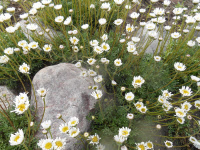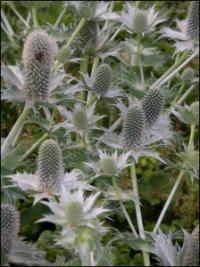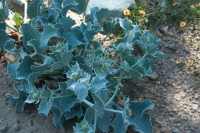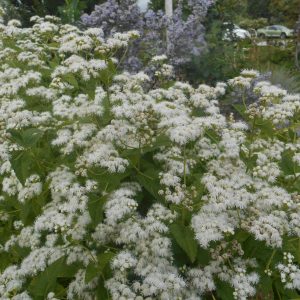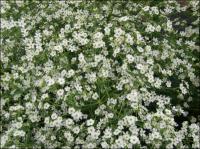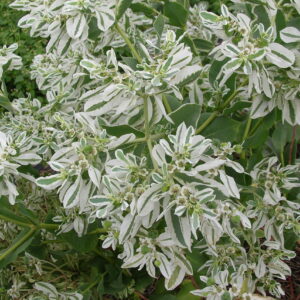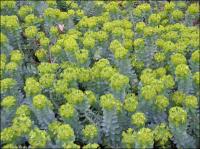Drought, Xeric & Dry Soil Plants
Showing 41–48 of 126 results
-
Erigeron compositus Cutleaf daisy, Dwarf mountain fleabane Z 3-8
Miniature, cushion shaped plant with wooly grey leaves topped by small bluish, pink or white rays like a daisy with a yellow center. Flowers in June-July.
Miniature, cushion shaped plant with wooly grey leaves topped by small bluish, pink or white rays like a daisy with a yellow center. Flowers in June-July.
Size: 6” x 6-12”
Care: sun to part shade in well-drained soil.
Native: all of western No. America from prairies to alpine slopes.Erigeron comes from Greek er meaning “spring” and geron for “old man” due to some of these species having white downy hair like an old man.
Thompson Indians from British Columbia chewed on the plant then spit on sores to remedy skin ailments. They also made a decoction of the plant, mixed with any weeds for broken bones. Collected by Meriwether Lewis in late spring 1806 near today’s Lewiston Idaho. Erigeron comes from Greek er meaning “spring” and geron for “old man” due to some of these species having white downy hair like an old man. -
Eryngium giganteum Miss Wilmott’s ghost SELF-SEEDING BIENNIAL Z 5-8
In summer, oval thistles top prickly green, turning steely blue, silvery, bracts – very ornamental.
In summer, oval thistles top prickly green, turning steely blue, silvery, bracts – very ornamental.
Size: 36" x 24"
Care: Full sun in moist well-drained, fertile soil. Be sure to let it drop its seeds & do not weed seedlings out the following spring.
Native: Caucasus Mountains
Awards: England's Royal Horticultural Society Award of Merit.Eryngium is Greek for thistle. This species introduced to England in 1820. Miss Ellen Willmott (1858-1934), a wealthy, expert, eccentric English gardener reputedly dropped seeds as she passed her neighbors’ gardens. The plants came up afterwards, her “ghosts.” Recommended by Gertrude Jekyll in 1908.
-
Eryngium maritimum Sea holly Z 5-10
Round thistles turning steely blue in July-August atop silver colored, prickly bracts. Attractive ivy-shaped prickly foliage.
OUT OF STOCK
Round thistles turning steely blue in July-August atop silver colored, prickly bracts. Attractive ivy-shaped prickly foliage.
Size: 12" x 10" slowly spreads
Care: Full sun in well-drained soil.
Native: Seacoasts of Europe“Eryngium” is Greek for thistle. Anglo-Saxons prescribed Sea holly root to cure the king’s evil, serpent bites, broken bones, stiff necks and melancholy. Also considered an aphrodisiac and brought on “kissing comfits.” This was identified by Dioscorides in De Materica Medica for medicinal use around 70 A.D. Eryngium was described in Gerard’s Herball in 1597 for its uses:” old and aged people that are consumed and withered with age, and which want natural moisture (and also) amended the defects of nature in the younger,” William Robinson, father of the mixed perennial border, considered this plant “very pretty.”
-
Eryngium planum Flat sea holly Z 5-9
Round thistles top prickly steel blue, silver colored, bracts June-August. Stems turn steel blue too. Deadhead for repeat bloom. Reseeds readily. Great cut flowers: dry or fresh…
Round thistles top prickly steel blue, silver colored, bracts June-August. Stems turn steel blue too. Deadhead for repeat bloom. Reseeds readily. Great cut flowers: dry or fresh.
Size: 36” x 18”
Care: Sun well-drained soil, drought tolerant
Native: E. EuropeEryngium is Greek meaning “thistle.” Described in Gerard’s Herball in 1597 for its uses to remedy: “old and aged people that are consumed and withered with age, and which want natural moisture (and also) amended the defects of nature in the younger.”
-
Eupatorium coelestinum album syn Conoclinium coelestinum ‘Album’ Mistflower ‘Album’ Z 3-7
Clusters of white in fall –close looks like a mophead of many strings, at a distance it looks like a big Ageratum - August to October.
Clusters of white in fall –close looks like a mophead of many strings, at a distance it looks like a big Ageratum – August to October.
Size: 3’ x 2-3’
Care: sun in moist to moist well-drained soil
Native: New Jersey west to Illinois south to Texas and east to Florida
Wildlife Value: attracts bees & butterflies - nectar source for American painted lady butterflyEupatorium named after Mithridates Eupator, ancient king of Pontus, Greece, said by Pliny to have used another species of Eupatorium medicinally in 1st century B.C. ‘Album’ first described and named in 1940.
-
Euphorbia corollata Flowering spurge Z 4-7
Small white flowers (bracts), like a baby's breath but better, July & August. One of the best prairie natives, but slow to mature.
Small white flowers (bracts), like a baby’s breath but better, July & August. One of the best prairie natives but slow to mature.
Size: 36' x 24" spreading slowly
Care: sun in well-drained to moist well-drained soil. Drought resistant.
Native: Canada to Florida and west through the plains, Wisconsin native
Wildlife Value: deer resistant. Its pollen & nectar feed endangered Karner Blue butterfly as well as other small butterflies, numerous bees, wasps and flies. Several birds eat the seeds.A favorite medicine among native Americans. Cherokee rubbed the plant’s juice on skin to cure cancer. Also used to remedy tooth aches and gonorrhea. Winnebago cut a 2.5” long root to clear stomach and steeped leaves for a baby’s colic. According to Breck (1851), “One of the most elegant species peculiar to the United States.”
-
Euphorbia marginata Snow-on-the-mountain reseeding ANNUAL Let seeds fall in autumn
Clean white variegated leaves and flowers (bracts), very showy midsummer to fall. Use caution with internal milky sap.
OUT OF STOCK
Clean white variegated leaves and flowers (bracts), very showy midsummer to fall. Use caution with internal milky sap.
Size: 18” x 10”
Care: sun moist well-drained soil, drought tolerant.
Native: Plains from Dakota to Texas
Size: Wonderful cut flower just be careful of the milky sap.Sioux crushed leaves in water and boiled it for a liniment to remedy swelling; boiled whole leaves in water to increase milk for new mothers. Collected on Lewis and Clark expedition three times, once July 28, 1806 along Marias River. A “most elegant species.” Breck, 1851.
-
Euphorbia myrsinites Donkeytail spurge Z 5-8
Chartreuse umbels at stem tips in early spring contrast succulent blue-gray foliage encircling the reclining stem.
Chartreuse umbels at stem tips in early spring contrast succulent blue-gray foliage encircling the reclining stem.
Can not ship to: Colorado.
Size: 4” x 12”
Care: Sun in well-drained soil
Native: Western Asia
Awards: Royal Horticultural Society Award of Merit.Euphorbia was named for Euphorbus, physician of Numibian King Juba, father of Ptolemy (c. 50 B.C. – 20 A.D.) Reputedly Euphorbus used spurge to remedy the King’s enlarged stomach. Euphorbus’s brother was Augustus Caesar’s physician. Myrsinites is a Greek word meaning “resembling myrtle.” This plant described by Swiss botanical scholar Conrad Gesner in his book Horti Germaniae published in 1541.

